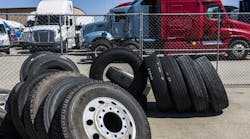Craig Tinklenberg of Fuller Brothers called tires and wheels the “jewels” of a fleet at a recent NationaLease meeting, implying that they were very valuable and needed to be treated with care.
He said one way to show care for tires is by monitoring their inflation pressure (they’re a pressure vessel, after all). Tinklenberg explained that a pressure vessel is a closed container designed to hold gases or liquids at a pressure substantially different from the ambient pressure. It seems to me that is a very apt description of a tire.
Everyone in the trucking industry talks about proper tire inflation. Here’s why:
- When a tire is properly inflated, it contacts with road evenly across its entire width.
- When a tire is overinflated, it contacts the road in the center of the tread
- And conversely, when a tire is underinflated the contact is concentrated at the edges of the tread.
Improperly inflated tires wear more quickly than those that are properly inflated. According to the American Transportation Research Institute’s An Analysis of the Operational Costs of Trucking: 2023 Update, because of rising global oil prices, tire prices are high, and they account for 2% of a fleet’s total average marginal cost of operation.
See also: What’s the next big thing in truck tires?
Unfortunately, not everyone is sure what proper inflation is, especially when you factor in things like the specific load on the tires, the speed the vehicle travels, and the ambient temperature the truck operates in.
Tinklenberg reminded the audience that tire manufacturers set tire pressure at 65°F. How many trucks are operating in 65°F ambient temperature? Temperature must be taken into consideration when setting cold inflation pressure for trucks operating temperatures below 55°F or above 77°F.
See also: Continental sets sights on 2030 and commercial tire market
The Occupational Health and Safety Administration (OSHA) has a standard definition of a flat tire which is a tire that has been driven underinflated at 80% or less of its recommended pressure. Tinklenberg says this means that any tire that has been operated for any distance at an air pressure level that is 20% of its cold loaded inflation pressure is considered flat.
Given that tires are pressure devices, technicians need to be careful when working on them. Tinklenberg's advice is to stay out of the trajectory zone when working on tires. OSHA defines trajectory as “any potential path or route that a rim wheel component may travel during an explosive separation or sudden release of the air pressure.”
Here are Tinklenberg’s tips for inflating tires.
- Use a clip-on air chuck with at least 20’ of hose.
- Use a remote inflation system with the valve core removed.
- Make sure the system is able to blow off the air quickly via a dump valve.
- Never inflate a tire with an inflation pressure that is more than 20% lower than its cold standard pressure. As an example, if a tire’s cold pressure is supposed to be 100 psi but it is at 79 psi or lower, do not inflate it.
- Use a safety cage or restraining device.
- Make sure no one is in the trajectory zone. If you can read the letters on the sidewall, you are in the trajectory zone.
The Technology & Maintenance Council has guidebooks covering tire inflation, tire wear, and proper tire repair procedures.
The good news for fleets is that there are technology solutions for monitoring tire inflation pressure. Tire pressure monitoring systems give fleets real-time tire performance data. Central tire inflations systems—which have come a long way since they were first introduced to the market—constantly check and set tire inflation pressure.
Jane Clark is vice president of member services for NationaLease. In this position, she is focused on managing the member services operation as well as working to strengthen member relationships, reduce member costs, and improve collaboration within the NationaLease supporting groups. Prior to joining NationaLease, Clark served as area vice president for Randstad, one of the nation's largest recruitment agencies, and before that, she served in management posts with QPS Cos., Pro Staff, and Manpower Inc.



